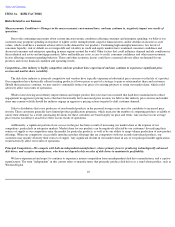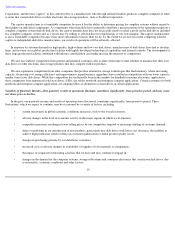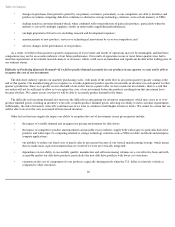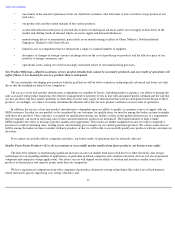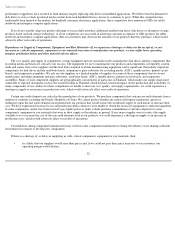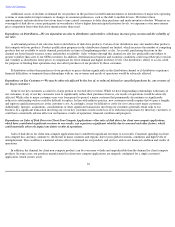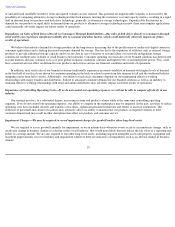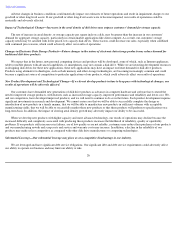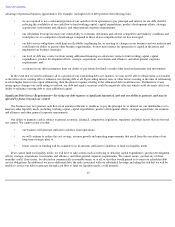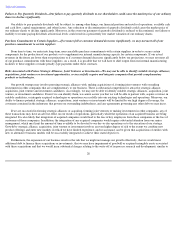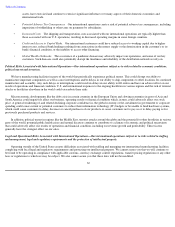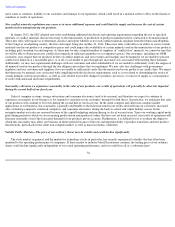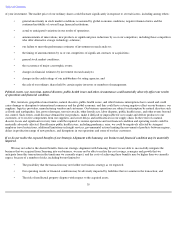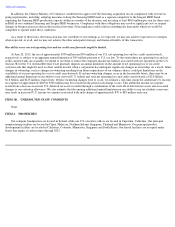Seagate 2012 Annual Report Download - page 31
Download and view the complete annual report
Please find page 31 of the 2012 Seagate annual report below. You can navigate through the pages in the report by either clicking on the pages listed below, or by using the keyword search tool below to find specific information within the annual report.
Table of Contents
Failure to Pay Quarterly Dividends—
Our failure to pay quarterly dividends to our shareholders could cause the market price of our ordinary
shares to decline significantly.
Our ability to pay quarterly dividends will be subject to, among other things, our financial position and results of operations, available cash
and cash flow, capital requirements, and other factors. Any reduction or discontinuation of quarterly dividends could cause the market price of
our ordinary shares to decline significantly. Moreover, in the event our payment of quarterly dividends is reduced or discontinued, our failure or
inability to resume paying dividends at historical levels could result in a persistently low market valuation of our ordinary shares.
Purchase Commitments to Certain Suppliers
—If revenues fall or customer demand decreases significantly, we may not meet all of our
purchase commitments to certain suppliers.
From time to time, we enter into long-term, non-cancelable purchase commitments with certain suppliers in order to secure certain
components for the production of our products or to supplement our internal manufacturing capacity for certain components. If our actual
revenues in the future are lower than our projections or if customer demand decreases significantly below our projections, we may not meet all
of our purchase commitments with these suppliers. As a result, it is possible that we will have to shift output from our internal manufacturing
facilities to these suppliers or make penalty-type payments under these contracts.
Risks Associated with Future Strategic Alliances, Joint Ventures or Investments
—We may not be able to identify suitable strategic alliances,
acquisitions, joint ventures or investment opportunities, or successfully acquire and integrate companies that provide complementary
products or technologies.
Our growth strategy may involve pursuing strategic alliances with, making acquisitions of, forming joint ventures with or making
investments in other companies that are complementary to our business. There is substantial competition for attractive strategic alliance,
acquisition, joint venture and investment candidates. Accordingly, we may not be able to identify suitable strategic alliances, acquisition, joint
venture, or investment candidates. Even if we can identify them, we cannot assure you that we will be able to partner with, acquire or invest in
suitable candidates, or integrate acquired technologies or operations successfully into our existing technologies and operations. Moreover, our
ability to finance potential strategic alliances, acquisitions, joint ventures or investments will be limited by our high degree of leverage, the
covenants contained in the indentures that govern our outstanding indebtedness, and any agreements governing any other debt we may incur.
If we are successful in forming strategic alliances or acquiring, forming joint ventures or making investments in other companies, any of
these transactions may have an adverse effect on our results of operations, particularly while the operations of an acquired business are being
integrated. It is also likely that integration of acquired companies would lead to the loss of key employees from those companies or the loss of
customers of those companies. In addition, the integration of any acquired companies would require substantial attention from our senior
management, which may limit the amount of time available to be devoted to our day-to-day operations or to the execution of our strategy.
Growth by strategic alliance, acquisition, joint venture or investment involves an even higher degree of risk to the extent we combine new
product offerings and enter new markets in which we have limited experience, and no assurance can be given that acquisitions of entities with
new or alternative business models will be successfully integrated or achieve their stated objectives.
Furthermore, the expansion of our business involves the risk that we might not manage our growth effectively, that we would incur
additional debt to finance these acquisitions or investments, that we may have impairment of goodwill or acquired intangible assets associated
with these acquisitions and that we would incur substantial charges relating to the write-off of in-process research and development, similar to
28


